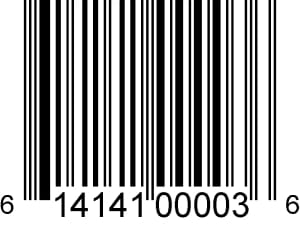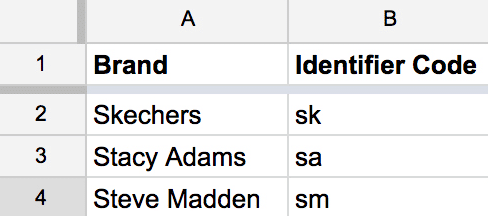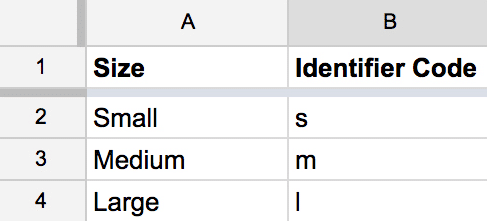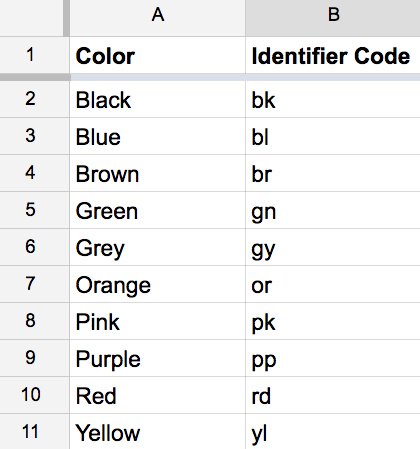SKU Numbers: understanding, utilizing, and best practices
If you’re like me, receiving orders never loses its excitement. But running a warehouse and keeping track of inventory can feel like an endlessly urgent cycle of incoming merchandise, outgoing orders, and returns. It can feel so overwhelming to keep up with it all that it’s easy to put off making changes. You guessed it, creating SKU numbers for inventory management is one change that will lay a good foundation for the future, increase efficiency, and allow your business to grow.
In this article, I’ll give you a full breakdown of everything you need to know about SKUs, including:
- Why they’re important and what they look like
- How they’re different from other tracking systems (like UPC codes)
- And how to get started creating your own SKU system for your ecommerce business.
Let’s dive in!
What does SKU stand for?
SKU stands for Stock Keeping Unit, and is pronounced: “skew.”
What’s the purpose of SKU numbers?
The purpose of a SKU number is to uniquely identify and track individual products within a company’s inventory system.
This identification number helps businesses manage their inventory more efficiently by enabling them to track the movement of each product from the time it enters the inventory until it is sold.
SKU numbers can contain alphanumeric characters, barcodes, or a combination of both, depending on the needs of the business.
By using SKU numbers, businesses can easily monitor their inventory levels, replenish stock in a timely manner, and prevent stockouts or overstocks.
They can also analyze sales data to identify which products are performing well and which ones need improvement, and make informed decisions on pricing, marketing, and promotions.
What’s the difference between a stock keeping unit (SKU) and a universal product code (UPC)?
This is an example of a UPC:
When looking at the difference between SKU vs UPC, remember:
- A SKU number is assigned by you, the seller, and is used only to track inventory internally. Universal Product Codes (UPC), which are assigned externally by a nonprofit, are used for external tracking by retailers and distributors at the POS system (point of sale).
- Creating SKUs does not have a standardized practice. But, the practice of creating UPCs is standardized.
- The same product from a different seller will likely have a different SKU. UPC codes will have the same code regardless of the seller.
- SKU numnber can be alpha-numeric. UPCs are only numeric.
- SKU numbers may be interpreted by humans, while UPC codes cannot.
What does a SKU number look like?
Let’s say that you’re a retail store selling Steve Madden black Terraa women’s shoes in size 6. Here’s a SKU number example for that product:
“Sm,” the abbreviation for the manufacturer, Steve Madden, is followed by, “terraa,” which is the name of the shoe. “Bk,” describes the color of the shoe, black. Finally, “6” is the size of the shoe.
Here’s another SKU number example for an Alloy Art 1” rear axle kit for a 2010 Harley Davidson that’s a little more complex:
“Aa,” the abbreviation for the manufacturer, Alloy Art, is followed by, “rak,” which is an abbreviation for the type of part that it is – a rear axle kit. “1,” describes the size of the part. “2010,” is the year. “Hd,” stands for Harley Davidson, which is the make of the motorcycle that the part is intended for.
Why a SKU system is important to your business
1) They are an industry standard
Stock-keeping units are industry standard throughout the supply chain (and all ecommerce, really). Operating as a seller without SKUs is like having a business without a website – you just can’t compete without it.
You may be getting by without using SKUs right now, but you really need them to function in any kind of multichannel selling. For example, Amazon will not allow you to list a product without a SKU.
2) They convey information quickly
SKU codes are chiefly used for communication by describing products in a way that helps everyone quickly get on the same page.
They are a form of shorthand, that if done well can communicate exactly what the product is at a glance.
3) They speed up warehouse processes and help you efficiently track inventory levels
SKU codes speed up the process of finding products because they allow you and your employees to search, track, and reference products and inventory levels in your warehouse (or basement).
There are many procedures that take place in a warehouse in the life of a product and SKUs can be used in each of these steps to shave seconds or even minutes off of the time a task takes to complete.
If you multiply those seconds saved by the hundreds of times a week or day each of those tasks gets completed, you’re looking at hours of time saved. And I don’t think I need to remind you that time is money.
4) They increase accuracy in warehouse procedures
Using SKU codes offers businesses the benefit of achieving significantly more accurate inventory management.
This is made possible by the ability to track inventory electronically in various ways. Barcode scanning, for instance, is known to be 99.99% accurate, which is much higher than relying solely on warehouse workers for manual inventory counts.
5) They improve quality control
With everyone in your warehouse or retail business reading SKU codes, you decrease the number of problems that occur because of miscommunication, which is the main source of human error.
Concise communication through the use of SKUs is just one more way to prevent things like mispicks and misships, and to make sure that orders go out correctly every time.
Creating SKUs and SKU management best practices
I hope I’ve convinced you that SKUs are essential parts of any successful inventory management system.
Now, let’s get down to the nitty-gritty of how to actually generate SKU numbers for your business.
Create a format
The first thing to do when creating SKUs is to create a standard format for all of your SKUs to follow.
Decide what numbers and identifiers will be included in your SKUs, and in what order.
Will you include the brand name? The color? The manufacturer’s part number? Think about what attributes your products typically have that distinguish them from other products to figure out what needs to be included.
Here’s an example of a SKU format:
manufacturer/brand identifier, part number or name, category identifier, product name-color identifier-size identifier
So, for a red Stacy Adam’s Men’s Gordon Shoe in size 9.5, the SKU might be, “samsgordon-rd-9.5”.
Take advantage of the alphanumeric SKU number system to make your SKU numbers as descriptive as possible.
If you can determine your SKU format now, you can save time in the future when you’re naming more SKUs because you’ll already know what to include. You’ll also know exactly how to read a SKU because the same attributes will be in the same place every time.
Create a coding system
You’ll want to create and maintain a list of codes for things like manufacturers, brands, colors, and sizes.
You can do this on a spreadsheet by making a list of the manufacturers and brands that you carry in one column, and then assigning a code to each of them.
That might look like:
The same goes for colors and sizes. You can add the variations to a spreadsheet and decide how you’ll abbreviate each of them.
For sizes, it might look like:
And for colors:
The benefit of creating a set of standard identifier codes to use when naming your SKUs is that you and your employees will begin to memorize them, and eventually be able to read and interpret SKUs quickly.
Remember, you don’t need to have a great long-form descriptive title for each item because you’ll be able to look at a SKU and know exactly the type of product that it’s representing.
So, save that long-form descriptive click-bait title for display on your marketplace(s) and your website(s)!
SKU naming best practices
There are no rules when it comes to SKU naming, but here are a few do’s and don’ts that you might want to consider to make things easier on yourself and your employees:
DO:
- Keep it short
- Use identifier codes like ‘s’ for small and ‘rd’ for red
- Uses dashes as separators
- Use sequences of numbers and letters
DON’T:
- Make them too long
- Include special characters like asterisks and ampersands. Some programs may not recognize those characters, so your SKU may not show up correctly or at all.
- Spell out every single word e.g. stacy-adams-mens-shoe-gordon-red-9.5
SKU generators
If you’d prefer not to name your SKU numbers manually, a SKU generator might be the way to go. Ecommerce platforms sometimes have SKU generators for their clients.
Bigcommerce is one example of this with its Auto-SKU Generator. We also offer SKU generation with our SkuVault Core product. With so many options to name SKUs, there’s no excuse not to do it!
Next steps
Take charge of your inventory today by taking these steps:
- Schedule a time to create your formatting, develop your codes, and name your SKUs.
- Create your formatting, codes, and name your SKUs.
- Implement a system to continue labeling, tracking, and naming new SKUs in your warehouse. Be consistent.
Creating SKUs will open the door to so many possibilities when it comes to tracking your inventory and growing your business by creating SKUs.
It may seem like a daunting task. But your business is worth the effort!
FAQs about SKUs and SKU systems
How is a SKU different from a barcode?
A SKU is an internal code used by retailers to manage their inventory, whereas a barcode is a machine-readable representation of data (usually a product’s UPC or EAN) used for scanning at the point of sale.
Barcodes are standardized and recognized globally, while SKUs are unique to each business.
How do I create a SKU?
When creating a SKU, follow these general guidelines:
- Keep it short, but informative: Include relevant product attributes, such as brand, size, and color.
- Use a consistent format: Establish a standard structure for your SKUs to make them easily recognizable and manageable.
- Avoid ambiguous characters: Refrain from using characters like O and 0 or I and 1, which can be easily confused.
- Make it human-readable: Ensure your SKU is easy to read, understand, and communicate verbally.
How do I implement a SKU system?
To implement a SKU system, follow these steps:
- Analyze your inventory: Identify the various product attributes that need to be included in your SKUs.
- Establish a SKU format: Determine the structure of your SKUs, ensuring consistency and readability.
- Assign SKUs to existing products: Create unique SKUs for each product in your inventory.
- Integrate SKUs into your business processes: Update your inventory management, sales, order fulfillment, and customer support systems to incorporate SKUs.
- Train your team: Educate your employees on the new SKU system and its benefits to ensure smooth adoption.
Do I need both a SKU number and a UPC code?
Yes, it is recommended to have both a SKU number and a UPC (Universal Product Code) for optimal inventory tracking.
A SKU number is specific to your business and helps you manage your inventory, while a UPC code is a standardized, globally recognized barcode used for product identification at the point of sale.
UPC codes are often required by retailers and ecommerce platforms to list products, and they facilitate scanning and tracking throughout the supply chain.
What are some SKU number examples?
SKU numbers vary based on the retailer’s chosen format, but here are a few examples:
- Example 1: ABC-12345-S-BL (Brand: ABC, Product ID: 12345, Size: Small, Color: Blue)
- Example 2: 01-200-GR-M (Department: 01, Item number: 200, Color: Green, Size: Medium)
- Example 3: NIK-RN4-10W (Brand: Nike, Model: RN4, Size: 10, Gender: Women)
The structure and information included in the SKU depend on the retailer’s preferences and the product’s specific attributes.
Is a SKU number the same as an item number?
A SKU number and an item number may refer to the same thing in some contexts, as both are unique identifiers for a product in a retailer’s inventory.
However, an item number may be a more generic term, while a SKU number typically includes specific product attributes such as brand, size, and color.
The use of these terms may vary between businesses, but the primary goal is the same: to track and manage inventory efficiently.
Why does Facebook Marketplace and Amazon need my product’s SKU number?
Facebook Marketplace, Amazon, and other ecommerce platforms require your product’s SKU number for several reasons:
- Inventory management: The SKU number helps the platform and seller manage inventory levels, track sales, and monitor product performance.
- Order fulfillment: It ensures that the correct product is picked, packed, and shipped to the customer, reducing errors and improving customer satisfaction.
- Product identification: The SKU number helps uniquely identify each product, reducing confusion and simplifying the listing process.
- Reporting and analytics: SKU numbers allow for the aggregation and analysis of sales data, enabling sellers to make informed decisions and optimize their product offerings.
Having a SKU number for your products simplifies the overall selling process and enhances the efficiency of the marketplace.
Is a SKU the same as a barcode?
No, a SKU (Stock Keeping Unit) is not the same as a barcode. A SKU is an alphanumeric code that is unique to each product in a retailer’s inventory and is used for internal inventory management purposes. SKUs are created by the retailer and can vary between businesses.
A barcode, on the other hand, is a machine-readable representation of data (usually a product’s UPC or EAN) that is standardized and globally recognized.
Barcodes are used for product identification at the point of sale and for tracking products throughout the supply chain. While SKUs are unique to each retailer, barcodes follow a standardized format that is recognized across different retailers and organizations.
Can SKUs be contained inside barcodes?
Yes, SKUs can be contained inside barcodes, but it requires a custom barcode system specifically designed for your business.
This can be achieved by encoding your SKU information directly into the barcode, which can then be read by barcode scanners or other data-collection devices.
In this case, the barcode would represent the unique SKU information you have assigned to your products, allowing you to manage your inventory more efficiently.
However, it is important to note that this custom barcode system would only work within your organization and may not be recognized by external systems or retailers that rely on standard barcode formats such as UPC or EAN.
Final thoughts
In conclusion, SKUs play a crucial role in inventory management, as they enable businesses to efficiently track, manage, and analyze their products.
By using a unique identifier, retailers can optimize their inventory control, order fulfillment, reporting, and customer support processes.
Barcodes, on the other hand, provide a standardized method for product identification and tracking throughout the supply chain.
Looking for a solution for both barcode management and inventory management as a whole?
Try SkuVault Core.
By providing an integrated platform that simplifies and streamlines inventory and barcode management, SkuVault Core helps businesses stay organized, efficient, and informed.
With a comprehensive set of features designed to optimize the entire inventory management process, SkuVault Core is the ideal partner for any retailer looking to improve their inventory control.
We encourage you to explore SkuVault Core’s features page to learn more about how this powerful software can revolutionize your inventory management.
Ready to see SkuVault Core in action? Book a live demo of the software, and witness firsthand how SkuVault Core can transform your business operations for the better.
FAQs
Ensuring uniqueness of SKU numbers across products and categories typically involves using a combination of product attributes in the SKU format. This might include elements such as brand names, product names, colors, sizes, and other distinguishing features. By incorporating these attributes into the SKU structure, businesses can minimize the risk of duplication and ensure that each SKU is distinct within their inventory system.
While there are no strict industry standards for structuring SKU numbers, businesses often establish their own formats based on their specific needs and preferences. However, it’s essential to consider factors such as readability, consistency, and scalability when designing a SKU format. Some common practices include including brand identifiers, product identifiers, and attribute identifiers in the SKU format to make them easily recognizable and manageable.
SKU numbers can typically be integrated into existing inventory management software through various methods, depending on the capabilities of the software and the needs of the business. Many inventory management systems allow for the creation and customization of SKU fields, making it easy to associate SKU numbers with product listings, inventory levels, and other relevant data. Additionally, businesses can use barcode scanning technology to link SKU numbers with physical inventory items, streamlining processes such as receiving, picking, and tracking inventory movements.






